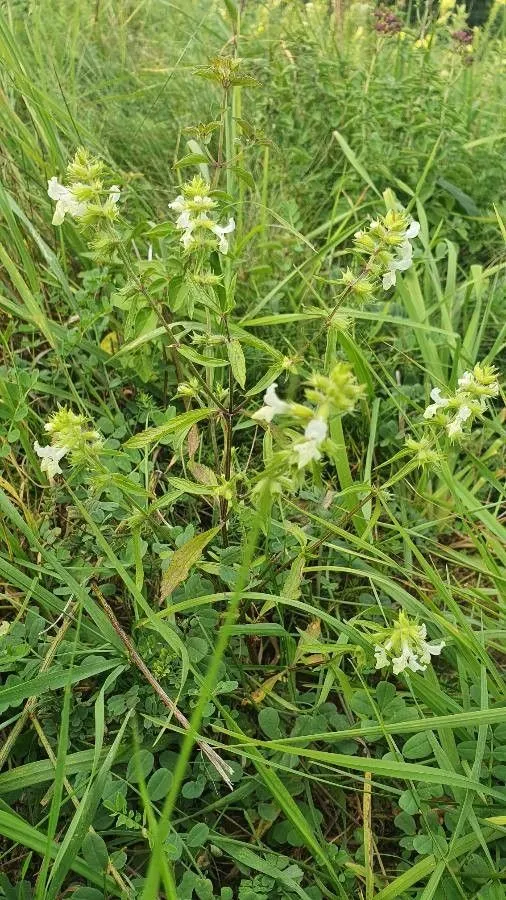
Author: (L.) L.
Bibliography: Sp. Pl. ed. 2: 813 (1763)
Year: 1763
Status: accepted
Rank: species
Genus: Stachys
Vegetable: False
Observations: Europe to Siberia and Iran
Annual Yellow Woundwort, scientifically known as Stachys annua, is a notable member of the Lamiaceae family. Initially documented in the Species Plantarum, second edition, page 813 in 1763 by the renowned botanist Carl Linnaeus, Stachys annua boasts a rich botanical heritage.
Native to a vast geographical range, Stachys annua can be found flourishing across diverse landscapes from the lush terrains of Europe, stretching through the vast expanses of Siberia, and reaching as far as the highlands and plains of Iran. Its adaptable nature allows it to thrive in a variety of environmental conditions, making it a resilient species within its genus.
The plant is characterized by its distinct yellow flowers which have been historically noted not only for their aesthetic appeal but also for their traditional use in herbal medicine, particularly in treating wounds—hence the name “woundwort.” The flowers bloom annually, making them a recurrent symbol of renewal in the regions they inhabit.
As a member of the prolific Lamiaceae family, Stachys annua shares the common traits of aromatic foliage and square stems, which are signature characteristics of plants within this family. These traits contribute to its identification and classification within the diverse group of flowering plants.
In summary, Annual Yellow Woundwort (Stachys annua) stands as an enduring example of botanical history and geographical adaptability, continuing to capture the interest of botanists and herbalists alike with its enduring presence from Europe to Asia.
Eng: annual yellow-woundwort, annual hedgenettle, annual hedge-nettle, annual woundwort, annual yellow woundwort, field woundwort
Deu: einjaehriger ziest, einjähriger ziest
Dan: enårig galtetand
Fra: epiaire annuelle, épiaire annuelle
Swe: gulsyska, keltapähkämö
Fin: keltapähkämö
Nno: orientsvinerot
Nob: orientsvinerot
Lav: vasaras s
Nld: zomerandoorn
Est: üheaastane nõianõges
Cym: briwlys unflwydd, briwlys-melyn blynyddol
En: Annual yellow woundwort, Annual hedge-nettle, Annual hedgenettle, Annual Yellow-woundwort, Annual woundwort, Field woundwort, Hedgenettle Betony
Hy: Աբեղախոտ միամյա
Be: Чысцік аднагадовы
Bg: Едногодишен ранилист
Cs: Čistec roční
Da: Enårig galtetand
Nl: Zomerandoorn
Et: Üheaastane nõianõges
Fi: Keltapähkämö
Fr: Epiaire annuelle, Épiaire annuelle
De: Einjähriger Ziest, Einjaehriger Ziest, Sommer-Ziest
Hu: Egynyári tisztesfű
It: Stregonia annuale, Stregona annuale
Lv: Vasaras s
Mk: Едногодишен чистец
Nb: Orientsvinerot
Nn: Orientsvinerot
Pl: Czyściec roczny
Ru: Чистец однолетний
Es: Hierba de la faridura
Sv: Gulsyska, Keltapähkämö
Cy: Briwlys unflwydd, Briwlys-Melyn Blynyddol
Taken May 23, 2020 by beurny (cc-by-sa)
Taken Jul 28, 2019 by Franco Colnago (cc-by-sa)
Taken May 23, 2020 by beurny (cc-by-sa)
Taken Sep 21, 2021 by Hana Kuchaříková (cc-by-sa)
Taken Jul 31, 2021 by Manuëlle (cc-by-sa)
Taken Sep 30, 2022 by Fabrice Rubio (cc-by-sa)
Taken Sep 30, 2022 by Fabrice Rubio (cc-by-sa)
Taken Nov 20, 2021 by Manuëlle (cc-by-sa)
Taken Aug 4, 2022 by kiscilinke56 (cc-by-sa)
Taken Jul 31, 2021 by Manuëlle (cc-by-sa)
Taken Sep 30, 2022 by Fabrice Rubio (cc-by-sa)
Taken Sep 30, 2022 by Fabrice Rubio (cc-by-sa)
Taken Nov 20, 2021 by Manuëlle (cc-by-sa)
Taken Jul 14, 2013 by Tela Botanica − Ans GORTER (cc-by-sa)
Taken Sep 21, 2021 by Hana Kuchaříková (cc-by-sa)
Taken Nov 6, 2022 by Anja Otto (cc-by-sa)
Taken Sep 8, 2021 by Jacques Maréchal (cc-by-sa)
Taken Aug 22, 2020 by Llandrich anna (cc-by-sa)
Taken Sep 30, 2022 by Fabrice Rubio (cc-by-sa)
Taken Aug 22, 2020 by Llandrich anna (cc-by-sa)
Taken Jul 1, 2019 by jeroenmurphy (cc-by-sa)
Taken Aug 25, 2018 by Mihajlo Tomić (cc-by-sa)
Taken Aug 15, 2008 by Photoflora – Benoit BOCK (©)
Taken Jul 31, 1872 by Tela Botanica − Herbier PONTARLIER-MARICHAL (cc-by-sa)
Taken Aug 20, 1902 by Tela Botanica − Anne-Marie GRIMAUD (cc-by-sa)
Taken Jul 15, 2018 by Tela Botanica − LINDA Lopez (cc-by-sa)
Taken Jan 1, 1970 by Photoflora – L’Abbé COSTE (©)
© copyright of the Board of Trustees of the Royal Botanic Gardens, Kew.
© copyright of the Board of Trustees of the Royal Botanic Gardens, Kew.
© copyright of the Board of Trustees of the Royal Botanic Gardens, Kew.
Growth habit: Forb/herb
Ph maximum: 8.0
Ph minimum: 7.5
Light: 7
Atmospheric humidity: 4
Bloom months: [‘jun’, ‘jul’, ‘aug’, ‘sep’, ‘oct’]
Soil nutriments: 6
Family: Myrtaceae Author: (F.Muell.) K.D.Hill & L.A.S.Johnson Bibliography: Telopea 6: 402 (1995) Year: 1995 Status:…
Family: Rubiaceae Author: Pierre ex A.Froehner Bibliography: Notizbl. Bot. Gart. Berlin-Dahlem 1: 237 (1897) Year:…
Family: Sapindaceae Author: Koidz. Bibliography: J. Coll. Sci. Imp. Univ. Tokyo 32(1): 38 (1911) Year:…
Family: Asteraceae Author: A.Gray Bibliography: Pacif. Railr. Rep.: 107 (1857) Year: 1857 Status: accepted Rank:…
Family: Fabaceae Author: Medik. Bibliography: Vorles. Churpfälz. Phys.-Ökon. Ges. 2: 398 (1787) Year: 1787 Status:…
Family: Aspleniaceae Author: (Cav.) Alston Bibliography: Bull. Misc. Inform. Kew 1932: 309 (1932) Year: 1932…